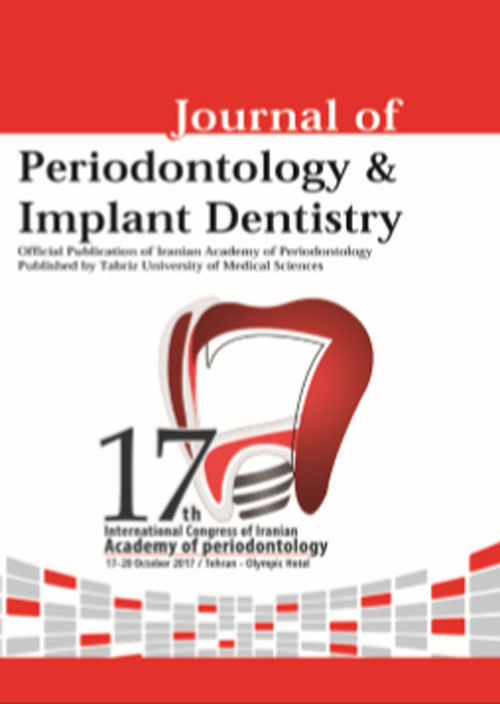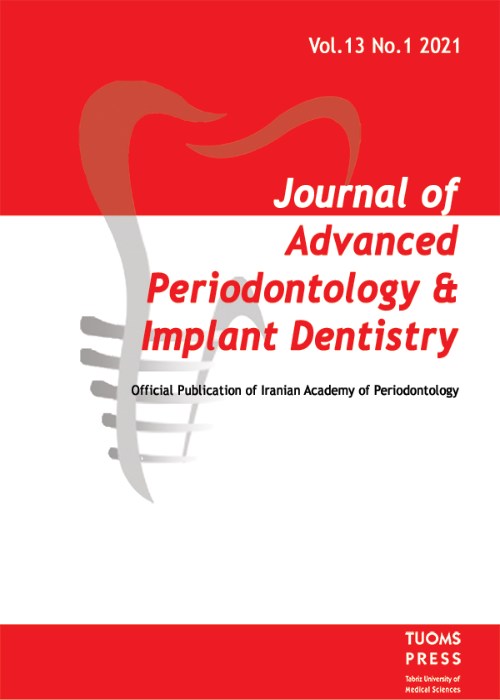فهرست مطالب

Journal of Advanced Periodontology and Implant Dentistry
Volume:13 Issue: 1, Jun 2021
- تاریخ انتشار: 1400/03/24
- تعداد عناوین: 9
-
-
Pages 2-6Background
Maxillary sinus pathologic conditions increase the risk of complications during sinus augmentation surgeries in the posterior maxilla. The present study aimed to determine the frequencies of maxillary sinus pathologic findings on patients’ cone-beam computed tomography (CBCT) images to receive dental implants.
MethodsIn this descriptive/cross-sectional study, 140 CBCT images of patients who were candidates to receive dental implants were evaluated for the presence of maxillary sinus pathologic entities during 6 months, were divided into five categories: mucosal thickening of >5 mm, retention cyst, partial or complete opacification of the sinus, polypoidal mucosal thickening, and healthy patients. Age, gender, and dental status were evaluated in terms of relationship with the sinus pathologic findings. Absolute and relative frequencies were used to describe data. The chi-squared test was used to analyze the variables. Statistical significance was set at P<0.05.
ResultsThe frequency of maxillary sinus pathologic entities on CBCT images was 63.5%. The pathologic conditions in descending frequency were as follows: mucosal thickening (31.4%), retention cyst (17.1%), partial or complete opacification of the sinus (9.3%), and polypoidal mucosal thickening (5.7%). The frequency of pathologic findings in the maxillary sinus was higher in the <46-year age group and subjects with partial edentulism; however, the differences were not significant.
ConclusionIn the present study, the most frequent maxillary sinus pathologic entity was mucosal thickening. There was no relationship between age, sex, and dentition status and maxillary sinus pathologic findings.
Keywords: Cone-beam computedtomography, Dental implants, edentulous, Maxillary sinuspathology, Posterior maxilla -
Pages 7-11Background
Glass ceramic materials have multiple applications in various prosthetic fields. Despite the many advantages of these materials, they still have limitations such as fragility and surface machining and ease of repairing. Crack propagation has been a typical concern in fullceramic crowns, for which many successful numerical simulations have been carried out using the extended finite element method (XFEM). However, XFEM cannot correctly predict a primary crack growth direction under dynamic loading on the implant crown.
MethodsIn this work, the dental implant crown and abutment were modeled in CATIA V5R19 software using a CT-scan technique based on the human first molar. The crown was approximated with 39514 spherical particles to reach a reasonable convergence in the results. In the present work, glass ceramic was considered the crown material on a titanium abutment. The simulation was performed for an impactor with an initial velocity of 25 m/s in the implant-abutment axis direction. We took advantage of smooth particle hydrodynamics (SPH) such that the burden of defining a primary crack growth direction was suppressed.
ResultsThe simulation results demonstrated that the micro-crack onset due to the impact wave in the ceramic crown first began from the crown incisal edge and then extended to the margin due to increased stress concentration near the contact region. At 23.36 µs, the crack growth was observed in two different directions based on the crown geometry, and at the end of the simulation, some micro-cracks were also initiated from the crown margin. Moreover, the results showed that the SPH algorithm could be considered an alternative robust tool to predict crack propagation in brittle materials, particularly for the implant crown under dynamic loading.
ConclusionThe main achievement of the present study was that the SPH algorithm is a helpful tool to predict the crack growth pattern in brittle materials, especially for ceramic crowns under dynamic loading. The predicted crack direction showed that the initial crack was divided into two branches after its impact, leading to the crown fracture. The micro-crack initiated from the crown incisal edge and then extended to the crown margin due to the stress concentration near the contact area.
Keywords: Crack propagation, Mechanical properties, Monolithic crowns, Numerical simulation, Smooth particle, Hydrodynamics -
Pages 12-14Background
Determining what dentists know and believe about periodontal tissue properties is important to establish prevention practices. The present study aimed to investigate the knowledge, attitude, and practice of general dental practitioners about the properties of periodontal tissue around retainable teeth in Birjand, Northeast Iran.
MethodsThe knowledge, practice, and attitude of 91 dentists about periodontal tissue properties around retainable teeth were assessed by a validated researcher-made questionnaire.
ResultsThe results showed that the mean score of dentists’ attitude, knowledge, and practice were 70.7, 88.2, and 77, respectively. The mean score of the attitude of male dentists was higher than females significantly (P = 0.014).
ConclusionIt is highly recommended that continuing courses should be held to improve their knowledge.
Keywords: Attitude, Dentists, Knowledge, Periodontal tissue, Practice -
Pages 15-21Background
This systematic review aimed to determine the effectiveness and outcomes of immediate loading methods for short dental implants.
MethodsThe authors independently conducted an electronic search in the PubMed, Embase, EBSCO, ProQuest, and Cochrane databases for relevant articles published until November 15, 2020. The references of the included studies were assessed, and a manual search was conducted in Google Scholar and PubMed to find additional relevant studies.
ResultsFinally, three studies were selected and included in this systematic review. Significant heterogeneity existed in the design of the included studies, and due to the low number of the included studies, the authors could not perform a meta-analysis. The studies showed that the survival rate of immediate-loaded short implants is comparable to conventional loading methods. However, more marginal bone loss is expected. Overall, the immediate loading of short dental implants might be clinically successful.
ConclusionBased on the results, immediate loading protocols might be safely used for short implants. However, caution should be exercised in interpreting these results. Future welldesigned randomized clinical trials with more participants and study power are necessary to support the findings of this systematic review.
Keywords: Immediate loading, Short implants, Single implants -
Pages 22-27Background
Gingival recession is a manifestation of the presence of periodontitis and the expression of its characteristics for a long time in the patient’s oral cavity. Loss of attachment and its association with gingival recession affect the prosthetic value of the tooth as they significantly change the center of axial rotation of the tooth. The present study aimed to determine the correlation between gingival recession and attachment loss.
MethodsData on gingival recession and loss of attachment were collected in two groups of patients:In the first group (n=34), cross-sectional data were collected; in the second group (n=64), previously collected data over 10 years were evaluated.
ResultsGingival recession was the most prevalent in the age group of 20-30 age group in 56% of the patients. The same values held for the retrograde data. An attachment loss of 4-6 mm was reported in 26% of the patients in the 31-50 age group in the cross-sectional data group, and 7 mm of gingival recession was reported in 3% of the patients in the 31-50 age group.
ConclusionsThe high prevalence of periodontitis at a young age indicates a poor prognosis of this disease at older ages. Gingival recession associated with attachment loss for patients with chronic periodontitis has higher values at the 31-50 age group, where systemic conditions are gradually developing in the human body
Keywords: Attachment loss, Cross-Sectional, Recession, Retrograde -
Pages 28-34Background
This cross-sectional study investigated the bone mineral density (BMD) in type 2 diabetes mellitus (T2DM) subjects with or without chronic periodontitis (CP).
MethodsA total of 120 subjects aged 35‒55, divided equally into four groups: i) T2DM with CP, ii) T2DM without CP, iii) CP alone, and iv) healthy patients, were included in this study. Clinical parameters like plaque index (PI), gingival index (GI), and probing pocket depth (PPD) were recorded. All the participants were evaluated for blood sugar levels using glycated hemoglobin (HbA1c) and BMD by Hologic dual-energy x-ray absorptiometry (DEXA) scan. The association of BMD with clinical periodontal parameters and HbA1c in all groups was investigated using linear correlation analysis (r).
ResultsThe mean value of BMD (0.9020±0.0952 g/cm2) was lower in subjects with both T2DM and CP compared to T2DM and CP alone. BMD was weakly correlated with all the clinical periodontal parameters; a positive correlation was observed between BMD and GI in the T2DM and CP group (r=0.405, P=0.026) and the CP group (r=0.324, P=0.081). A weak positive correlation was observed in BMD and HbA1c in the T2DM group (r=0.261, P=0.13), T2DM and CP group (r=0.007, P=0.970), with a negative correlation to HbA1c in the CP group (r= -0.134, P=0.479).
Conclusions:
Diabetes mellitus impacts clinical periodontal status and bone mass, and the effect is accentuated when chronic periodontitis is present. Based on the present study, BMD is associated with T2DM and CP, but a weak correlation was observed between BMD and HbA1c and clinical periodontal parameters.
Keywords: Bone resorption, Dual-energy x-ray, Absorptiometry scan, Glycated hemoglobin A, Inflammation, Osteoporosis -
Pages 35-42
Dental implant treatment in the posterior maxilla encounters bone quality and quantity problems. Sinus elevation is a predictable technique to overcome height deficiency in this area. Transalveolar sinus elevation is a technique that is less invasive and less time-consuming, first introduced for ridges with at least 5 mm of bone height. Many modifications and innovative equipment have been introduced for this technique. This review aimed to explain the modifications of this technique with their indications and benefits. An exhaustive search in PubMed Central and Scopus electronic databases was performed until December 2020. Articles were selected that introduced new techniques for the transalveolar maxillary sinus approach that had clinical cases with full texts available in the English language. Finally, twenty-six articles were included. The data were categorized and discussed in five groups, including expansion-based techniques, drill-based techniques, hydraulic pressure techniques, piezoelectric surgery, and balloon techniques. The operator’s choice for transalveolar approach techniques for sinus floor elevation can be based on the clinician’s skill, bone volume, and access to equipment. If possible, a technique with simultaneous implant placement should be preferred.
Keywords: Dental implant, Maxillary sinus, Sinus floor augmentation, Transalveolar maxillary sinus, elevation -
Pages 43-47
It seems quite challenging in tissue engineering to synthesize a base material with a range of essential activities, including biocompatibility, nontoxicity, and antimicrobial activities. Various types of materials are synthesized to solve the problem. This study aimed to provide the latest relevant information for practitioners about antibacterial scaffolds in dental tissue engineering. The PubMed search engine was used to review the relevant studies with a combination of the following terms as search queries: tissue engineering, scaffolds, antimicrobial, dentistry, dental stem cells, and oral diseases. It is noteworthy to state that only the terms related to tissue engineering in dentistry were considered. The antimicrobial scaffolds support the local tissue regeneration and prevent adverse inflammatory reactions; however, not all scaffolds have such positive characteristics. To resolve this potential defect, different antimicrobial agents are used during the synthesis process. Innovative methods in guided tissue engineering are actively working towards new ways to control oral and periodontal diseases.
Keywords: Antimicrobial agents, Endodontics, Oral diseases, Pediatric dentistry, Periodontitis, Scaffolds, Stem cell, Tissue engineering


